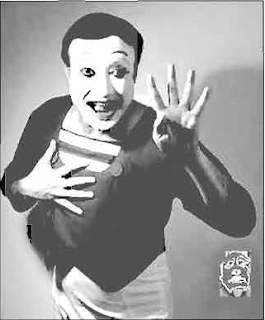A. Look at the above pictures of Partha Pratim Majumder. Work in pairs and discuss the following questions.
1 What is Partha Pratim Majumder doing in the two pictures?
2 Describe his facial expressions.
3 Describe his physical features i.e. his age, how he looks, what he is wearing, his hair style, etc.
Now write a short description of Partha Pratim Majumder.
B. Read the text and choose the correct answer.
Before the beginning of human language, communication took place between humans through signs and gestures. As humans began to use their vocal chords, these silent gestures were no longer used as the primary means of communication. But these did not completely disappear. They evolved as a form of art which came to be known as 'mime'.
In a Bangladeshi village, a little boy came to know about mime as he watched a performance in his village. He was so fascinated by the show that he was determined to master this art. The name of that little boy was Partha Pratim Majumder.
Majumder is undoubtedly a forerunner in the field of mime in Bangladesh. He started as a musician and his keen sense of rhythm helped him to let his limbs move and express his thoughts through gestures.
Partha Pratim Majumder is the first Bangladeshi to take up mime as a profession. He performed in a number of television shows in Bangladesh and gained popularity. In his mimes, Majumder depicted the day-to-day life of the people-their sadness, tears as well as their happiness and laughter.
Majumder's turning point came in 1979, when he was asked to give a solo performance at Bangladesh Shilpakala Academy. The French ambassador to Bangladesh at the time, Mr. Loic Moreau happened to be among the audience. Mr. Moreau noticed the talent in Majumder. In 1981, the French Government offered him a scholarship so that he could get professional training in mime. This was the first time that a student was granted a French scholarship in mime. Majumder started his training under the legendry maestro, Etiene Decroux. Through Decroux, he met another celebrated mime artist named Marcel Marceau. Marceau has transformed modern mime by taking it to an unimaginable height.
Marceau was very impressed by the young Bangladeshi talent and offered him a place in his school for mime, named 'Ecole Internationale de Mimodrame de Paris Marcel Marceau1. This mime school is the biggest and the best in the world.
During his three year training period, Majumder practised 16-18 hours daily till each and every bone in his body would feel like breaking.
After his time with Marceau, there was no looking back for Majumder. He staged solo performances in England, Belgium, Germany, Spain, Italy and the USA. French, Canadian and American TV channels enthusiastically aired his shows.
In 2009, a French play featuring Majumder won the "Moliere Award" which is the highest distinction in the French Theatre.
As a pioneer of the art of mime in Bangladesh and for popularizing the artistic genre, Bangladesh Government honoured the artiste with the "Ekushey Padok" in 2010.
The Government of France has also honoured him for his contribution to the art of mime throughout the world with one of the highest cultural awards of France titled "Chevalier de I' odre des Arts et des Lettres" (Knight in the order of Arts and Letters) in the year 2011.
[Sources: The Star Magazine, a weekly publication of The Daily Star, 27 January 2012 and Partha Pratim Majumder's Letter to Chairman NCTB, 2 February 2013]
Questions: Choose the best answer.
1. Before the use of speech, communication took place through........ language.
a) written
b) sign
c) spoken
d) art
2. In what form have the silent gestures evolved into?
a) drama
b) cinema
c) mime
d) dance
3. In olden times the actors who performed mime used to put white paint on their
a) limbs
b) body
c) face
d) hair
4. The word 'fascinated' in the second paragraph of the text means
a) enchanetd
b) encouraged
c) silenced
e) upset
C. Read the text in B again. Say if the following statements are true or false? If false, give the correct information.
1 The ancient Egyptian art shows that people at that time interacted with one another through signs.
2 In ancient times, humans used a few words as the primary means of interaction.
3 Partha Pratim Majumder is among the first few who performed mime in Bangladesh.
4 The turning point in Majumder's life was when he performed at Bangladesh Shilpakala Academy.
5 Marcel Marceau's school of mime is in Barcelona.
D. Read the text in B again and write answers to the questions.
1 What is*'mime'?
2 What helped Majumder to express himself clearly while performing mime?
3 What did he depict through his performance at the beginning?
4 Why was the French ambassador impressed when he saw Majumder's performance?
5 Describe the awards in art and culture that Majumder received. Why were they given to him?
E. Project: Do you know anyone who has skills to perform a special feat?
Write about the person, covering the following points.
• the first time the person came to know about it
• the time when the person began to practise it
• people who supported him/her
• his/her achievements/recognitions
If you do not know anyone, make a search and then write about the person based on the above guideline.
If you want to read the next lesson of this unit please click the link below:
If you want to read the next lesson of this unit please click the link below:







0 Comments:
Post a Comment